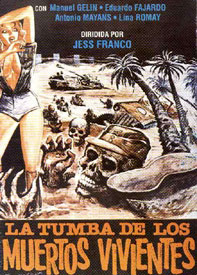 Oasis of the Zombies (1981) is famously bad. It has been recycled under sundry names including Oasis of the Living Dead, Bloodsucking Nazi Zombies & Treasure of the Living Dead, among other titles.
Oasis of the Zombies (1981) is famously bad. It has been recycled under sundry names including Oasis of the Living Dead, Bloodsucking Nazi Zombies & Treasure of the Living Dead, among other titles.
Spanish director Jesus Franco has been a one-man cinema mill, pumping out cheezy international exploitation product of little to no merit for three decades, top heavy in horror productions.
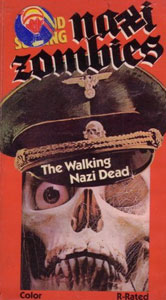 Anyone who sticks to it that long, getting no better at it, is bound to have his following, but I don't stand in their ranks, despite that I can like some pretty bad stuff. Anyone who sticks to it that long, getting no better at it, is bound to have his following, but I don't stand in their ranks, despite that I can like some pretty bad stuff.
The desert setting amidst camels, palm trees & robed muslim caravaneers could have been fairly novel for an otherwise standard zombie film.
But how odd nobody bothered to write a script that required Arabs or the desert or any degree of cultural or environmental uniqueness.
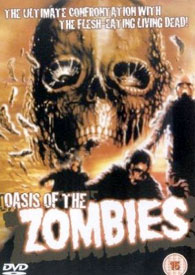 This Euro-schlock doggy is so cheap & crummy one has to be in an awfully tolerant mood to get a modicum of seedy exploitation value out of it. This Euro-schlock doggy is so cheap & crummy one has to be in an awfully tolerant mood to get a modicum of seedy exploitation value out of it.
Out of the gate we get soldier shoot-outs to establish as clearly as possible that this is not a film that needs any characterization. All any of this action induces is the query, "Where the hell are the zombies?"
It'll be half an hour before much else begins happening. We meet thinly drawn treasure hunters.
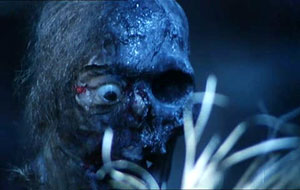 They arrive at the oasis where there are a couple of WWII relics to indicate this is where the Nazi treasure is hidden. Come nightfall, a one-eyed corpse comes alive & chokes some guy then nazi zombies start shambling through the night killing everyone. They arrive at the oasis where there are a couple of WWII relics to indicate this is where the Nazi treasure is hidden. Come nightfall, a one-eyed corpse comes alive & chokes some guy then nazi zombies start shambling through the night killing everyone.
Slow though the shambling corpses are, they capture people to nibble with great ease, to the monotonous sound of organ music. After everyone is killed, a second cast is introduced & set out for the same oasis & the same fate.
They know in advance that there will be zombies guarding the treasure but they are even so totally unprepared. Some of the zombie make-up is fun but not fun enough to justify time spent on this thing.
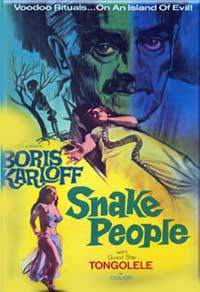 Drawing unlikely parallels to the ancient Cretan snake-goddess, this Mexican tale of modern voodoo is a nonsensical mishmash of movie cliches about voodoo as decadent, primitive, & evil. Drawing unlikely parallels to the ancient Cretan snake-goddess, this Mexican tale of modern voodoo is a nonsensical mishmash of movie cliches about voodoo as decadent, primitive, & evil.
If dancing with a snake or a chicken doesn't strike the viewer as inherently horrific, then Snake People aka Isle of the Snake People aka Isle of the Living Dead (1971) certainly provides no reason beyond bigotry against Carribean religion to suspend disbelief.
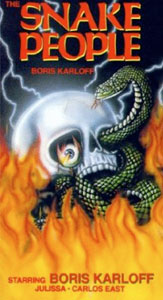 The dwarf voodoo priest played by "Santanon" is an antic fellow with a gloriously disgusting screen presence, throwing himself wholeheartedlly into a role offensive to little people. The dwarf voodoo priest played by "Santanon" is an antic fellow with a gloriously disgusting screen presence, throwing himself wholeheartedlly into a role offensive to little people.
He never becomes a real character rather than a filmic "sinister dwarf" as though dwarfism (like voodoo) were itself inherently creepy. Nevertheless, I think he's cooler'n ratshit & a much more thrilling character than Boris was able drummed up.
I don't think these sorts of assumptions have played well as horror since the 1940s. Dwarfs are just little people & voodoo is just a religion.
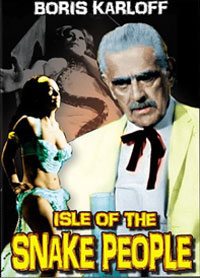 If the latter is to be presented in a horrific light, it needs to include a reason to assume a dark branch of the faith has gone off the rails, as is the case in the superior horror film Angel Heart (1987). If the latter is to be presented in a horrific light, it needs to include a reason to assume a dark branch of the faith has gone off the rails, as is the case in the superior horror film Angel Heart (1987).
Boris Karloff on the last legs of his life & career agreed to appear in four Mexican cheapies back to back, just to stay employed at a time when he could barely walk. His few scenes are very badly integrated with the bulk of the film, almost as though his role was patched in as an afterthought.
When his character finally gets together with the rest of the cast in the climax, he is wearing a black hood so that some Mexican actor can be his stand in, & Karloff didn't even loop in his own voice.
The scenes he is actually in were shot in L.A. completely separate from the Juan Ibanez's film shot in Mexico; Karloff's scenes were directed by Jack Hill, a never very successful schlock director who maaged to out-schlock himself.
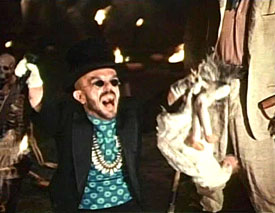 To describe this crud makes it sound a lot more interesting than it is. The dwarf priest is manufacturing zombies from slain soldiers, apparently by a method that requires painting them blue. They stumble around the island causing mischief. To describe this crud makes it sound a lot more interesting than it is. The dwarf priest is manufacturing zombies from slain soldiers, apparently by a method that requires painting them blue. They stumble around the island causing mischief.
One guy falls in love with a girl zombie because he always wanted a girlfriend who was mute. That was sufficiently perverse that it should've been more fully developed, but the director seems to have been pathological in avoiding whatever little plot elements might've fascinated.
Between the dwarf & Karloff & exotic dancer given in the credits as "Tongolele" (Yolanda Montes). there's often something on the screen fun to look at, but the sound might as well be turned off & just make up your own story as it goes along.
Adding up these barely-connected bits & throwing in some zombie chicks who eat a cop, perhaps it's sufficiently camp-worthy to waste some time on. But unless someone is inherently afraid of innocuous snakes or the Blue Man Group, there's scarsely a moment of terror in any of it, & no attempt at a consistent story.
Continue to:
The Plague of Zombies (1966)
copyright © by Paghat the Ratgirl
|
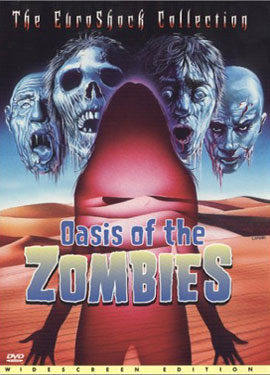

 Anyone who sticks to it that long, getting no better at it, is bound to have his following, but I don't stand in their ranks, despite that I can like some pretty bad stuff.
Anyone who sticks to it that long, getting no better at it, is bound to have his following, but I don't stand in their ranks, despite that I can like some pretty bad stuff. This Euro-schlock doggy is so cheap & crummy one has to be in an awfully tolerant mood to get a modicum of seedy exploitation value out of it.
This Euro-schlock doggy is so cheap & crummy one has to be in an awfully tolerant mood to get a modicum of seedy exploitation value out of it. They arrive at the oasis where there are a couple of WWII relics to indicate this is where the Nazi treasure is hidden. Come nightfall, a one-eyed corpse comes alive & chokes some guy then nazi zombies start shambling through the night killing everyone.
They arrive at the oasis where there are a couple of WWII relics to indicate this is where the Nazi treasure is hidden. Come nightfall, a one-eyed corpse comes alive & chokes some guy then nazi zombies start shambling through the night killing everyone.
 The dwarf voodoo priest played by "Santanon" is an antic fellow with a gloriously disgusting screen presence, throwing himself wholeheartedlly into a role offensive to little people.
The dwarf voodoo priest played by "Santanon" is an antic fellow with a gloriously disgusting screen presence, throwing himself wholeheartedlly into a role offensive to little people. If the latter is to be presented in a horrific light, it needs to include a reason to assume a dark branch of the faith has gone off the rails, as is the case in the superior horror film Angel Heart (1987).
If the latter is to be presented in a horrific light, it needs to include a reason to assume a dark branch of the faith has gone off the rails, as is the case in the superior horror film Angel Heart (1987). To describe this crud makes it sound a lot more interesting than it is. The dwarf priest is manufacturing zombies from slain soldiers, apparently by a method that requires painting them blue. They stumble around the island causing mischief.
To describe this crud makes it sound a lot more interesting than it is. The dwarf priest is manufacturing zombies from slain soldiers, apparently by a method that requires painting them blue. They stumble around the island causing mischief.